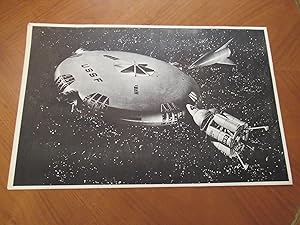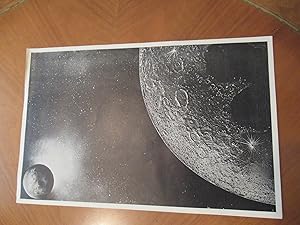robert heinlein jack eaman jacque (2 risultati)
Tipo di articolo
- Tutti gli articoli
- Libri
- Riviste e Giornali
- Fumetti
- Spartiti
- Arte, Stampe e Poster
- Fotografie (2)
- Mappe
-
Manoscritti e
Collezionismo cartaceo
Condizioni
- Tutte
- Nuovi
- Antichi o usati
Legatura
- Tutte
- Rilegato
- Brossura
Ulteriori caratteristiche
- Prima edizione
- Copia autografata
- Sovraccoperta
- Con foto
- No print on demand
Paese del venditore
Valutazione venditore
-
(Science Fiction Art) Concept Design For Space Station In Film "Project Moonbase"
Editore: Galaxy Pictures, Los Angeles, 1953
Da: Arroyo Seco Books, Pasadena, Member IOBA, Pasadena, CA, U.S.A.
Membro dell'associazione: IOBA
Fotografia Prima edizione
No Binding. Condizione: Fine. 1st Edition. 17" X 1". Reproduction Of Photograph Montage Used For Central Concept In "Project Moonbase", Written By Seaman And Heinlein. The Film Was Made In Ten Days, Including Use Of Same Sets For Another Film Shot Simultaneously. Often Criticized As A Film, But Mostly By People Who Couldn't Build A Radio Today Let Alone A Space Station In 1953. From The Forrest Ackerman Collection. Jacque Fresco (1916 ? 2017) Was An American Futurist And Self-Described Social Engineer. Self-Taught, He Worked In A Variety Of Positions Related To Industrial Design. Fresco Worked At Douglas Aircraft Company In California During The Late 1930S. He Presented Designs Including A Flying Wing] And A Disk-Shaped Aircraft. Fresco Was Commissioned By Earl "Madman" Muntz, To Design Low Cost Housing. Muntz Invested $500,000 Seed Money In The Project. Fresco, 32 Years Old At The Time, Along With His Associates Harry Giaretto And Eli Catran Conceived, Designed And Engineered A Project House Called The Trend Home. Built Mostly Of Aluminum And Glass, It Was On Prominent Display At Stage 8 Of The Warner Bros. Sunset Lot In Hollywood For Three Months. Without Federal Or Further Private Funding The Project Did Not Go Into Mass Production. This Experience Led Fresco To The Conclusion That Society Would Have To Be Changed For His Inventions To Reach Their Potential.In The Late 1940S, Fresco Created And Was Director Of Scientific Research Laboratories In Los Angeles. Here He Also Gave Lectures, And Taught Technical Design, Meanwhile Researching And Working On Inventions As A Freelance Inventor And Scientific Consultant. During This Period, Fresco Struggled To Get His Research Funded And Faced Setbacks And Financial Difficulties. In 1955, Fresco Left California After His Laboratory Was Removed To Build The Golden State Freeway.In 1955 Fresco Moved To Miami, Florida. In Miami Fresco Presented Designs Of A Circular City. Fresco Made His Living Working As An Industrial Designer For Various Companies Such As Alcoa And The Major Realty Corporation. In 1961, With Pietro Belluschi And C. Frederick Wise, Fresco Collaborated On A Project, Known As The Sandwich House. Consisting Of Mostly Prefabricated Components, Partitions, And Aluminum, It Sold For $2,950, Or $7,500 With Foundation And All Internal Installations. During This Period, Fresco Supported His Projects By Designing Prefabricated Aluminum Devices Through Jacque Fresco Enterprises Inc. From 1955 To 1969 Fresco Named His Social Ideas "Project Americana". Looking Forward Was Published In 1969. Author Ken Keyes Jr., And Jacque Fresco Coauthored The Book, A Speculative Look At The Future. The Authors Picture An Ideal 'Cybernetic Society In Which Want Has Been Banished And Work And Personal Possessions No Longer Exist; Individual Gratification Is The Total Concern' .Fresco Formed "Sociocyberneering", A Membership Organization Claiming 250 Members.] He Hosted Lectures In Miami Beach And Coral Gables. Fresco Promoted His Organization By Lecturing At Universities And Appearing On Radio And Television. Fresco's "Sociocyberneering" As A Membership Group Was Discontinued And Land Was Purchased At Another Location In Rural Venus, Florida. He Established His Home And Research Center There.Fresco, With Meadows, Supported The Project In The 1990S Through Freelance Inventing, Industrial Engineering, Conventional Architectural Modeling, And Invention Consultations. In 2002, Fresco Published His Main Work The Best That Money Can't Buy. In 2006, William Gazecki Directed The Semi-Biographical Film About Fresco, Future By Design.In 2008, Peter Joseph Featured Fresco In The Film Zeitgeist Addendum Where His Ideas Of The Future Were Given As Possible Alternatives. Peter Joseph, Founder Of The Zeitgeist Movement Began Advocating Fresco's Approach. In April 2012, The Two Groups Disassociated Due To Disagreements Regarding Goals And Objectives.
-
(Science Fiction Art) Concept Design For Moon In Film "Project Moonbase"
Editore: Galaxy Pictures, Los Angeles, 1953
Da: Arroyo Seco Books, Pasadena, Member IOBA, Pasadena, CA, U.S.A.
Membro dell'associazione: IOBA
Fotografia Prima edizione
No Binding. Condizione: Fine. 1st Edition. Reproduction Of Photograph Montage Used For Central Concept In "Project Moonbase", Written By Seaman And Heinlein. The Film Was Made In Ten Days, Including Use Of Same Sets For Another Film Shot Simultaneously. Often Criticized As A Film, But Mostly By People Who Couldn't Build A Radio Today Let Alone A Space Station In 1953. From The Forrest Ackerman Collection. 17" X 11". Jacque Fresco (1916 ? 2017) Was An American Futurist And Self-Described Social Engineer. Self-Taught, He Worked In A Variety Of Positions Related To Industrial Design. Fresco Worked At Douglas Aircraft Company In California During The Late 1930S. He Presented Designs Including A Flying Wing] And A Disk-Shaped Aircraft. Fresco Was Commissioned By Earl "Madman" Muntz, To Design Low Cost Housing. Muntz Invested $500,000 Seed Money In The Project. Fresco, 32 Years Old At The Time, Along With His Associates Harry Giaretto And Eli Catran Conceived, Designed And Engineered A Project House Called The Trend Home. Built Mostly Of Aluminum And Glass, It Was On Prominent Display At Stage 8 Of The Warner Bros. Sunset Lot In Hollywood For Three Months. Without Federal Or Further Private Funding The Project Did Not Go Into Mass Production. This Experience Led Fresco To The Conclusion That Society Would Have To Be Changed For His Inventions To Reach Their Potential.In The Late 1940S, Fresco Created And Was Director Of Scientific Research Laboratories In Los Angeles. Here He Also Gave Lectures, And Taught Technical Design, Meanwhile Researching And Working On Inventions As A Freelance Inventor And Scientific Consultant. During This Period, Fresco Struggled To Get His Research Funded And Faced Setbacks And Financial Difficulties. In 1955, Fresco Left California After His Laboratory Was Removed To Build The Golden State Freeway.In 1955 Fresco Moved To Miami, Florida. In Miami Fresco Presented Designs Of A Circular City. Fresco Made His Living Working As An Industrial Designer For Various Companies Such As Alcoa And The Major Realty Corporation. In 1961, With Pietro Belluschi And C. Frederick Wise, Fresco Collaborated On A Project, Known As The Sandwich House. Consisting Of Mostly Prefabricated Components, Partitions, And Aluminum, It Sold For $2,950, Or $7,500 With Foundation And All Internal Installations. During This Period, Fresco Supported His Projects By Designing Prefabricated Aluminum Devices Through Jacque Fresco Enterprises Inc. From 1955 To 1969 Fresco Named His Social Ideas "Project Americana". Looking Forward Was Published In 1969. Author Ken Keyes Jr., And Jacque Fresco Coauthored The Book, A Speculative Look At The Future. The Authors Picture An Ideal 'Cybernetic Society In Which Want Has Been Banished And Work And Personal Possessions No Longer Exist; Individual Gratification Is The Total Concern' .Fresco Formed "Sociocyberneering", A Membership Organization Claiming 250 Members.] He Hosted Lectures In Miami Beach And Coral Gables. Fresco Promoted His Organization By Lecturing At Universities And Appearing On Radio And Television. Fresco's "Sociocyberneering" As A Membership Group Was Discontinued And Land Was Purchased At Another Location In Rural Venus, Florida. He Established His Home And Research Center There.Fresco, With Meadows, Supported The Project In The 1990S Through Freelance Inventing, Industrial Engineering, Conventional Architectural Modeling, And Invention Consultations. In 2002, Fresco Published His Main Work The Best That Money Can't Buy. In 2006, William Gazecki Directed The Semi-Biographical Film About Fresco, Future By Design.In 2008, Peter Joseph Featured Fresco In The Film Zeitgeist Addendum Where His Ideas Of The Future Were Given As Possible Alternatives. Peter Joseph, Founder Of The Zeitgeist Movement Began Advocating Fresco's Approach. In April 2012, The Two Groups Disassociated Due To Disagreements Regarding Goals And Objectives.



